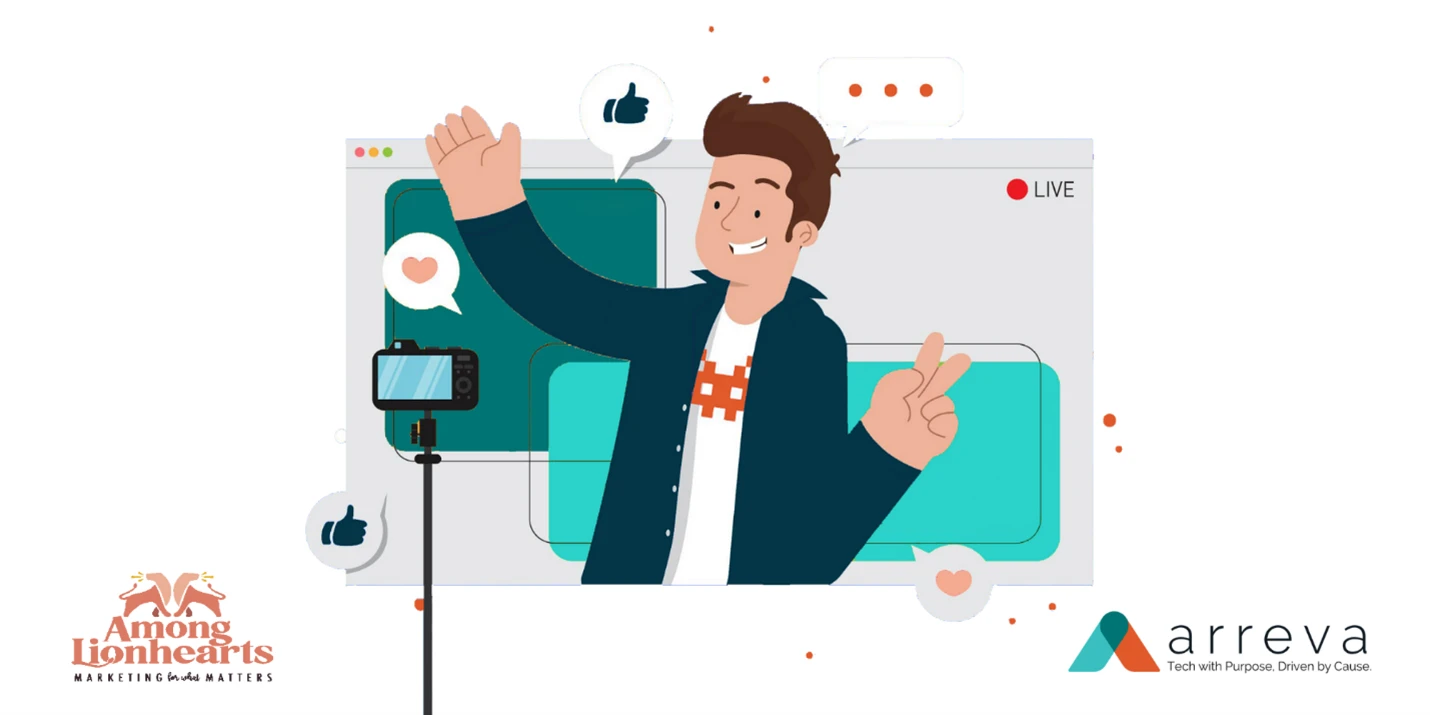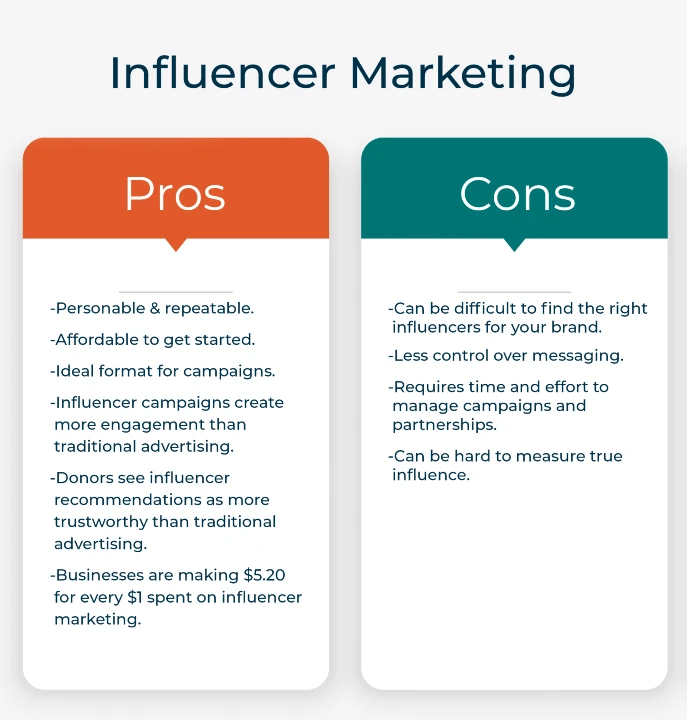How Influencer Marketing Helps Your Nonprofit Organization

In the modern world, it is becoming more and more challenging to get a person's attention. There are now over 500 million tweets sent per day on Twitter [1], more than 2.89 billion active monthly users on Facebook[2], roughly 1 billion on Instagram[3], and over 774 million on YouTube around the world[4]. With so many different types of social media constantly vying for consumers' attention, it can be hard to get noticed - but influencers have managed to do just that. Their following can provide companies with an avenue to communicate their message while reaching a targeted audience at the same time.
So, how can charities effectively harness influencers for their fundraising campaigns? How does influencer marketing help nonprofit organizations, specifically? And are influencers just a passing trend? Let's explore some answers to these influencer questions.
What is influencer marketing, and how does it work?
Influencer marketing is a form of outreach that uses highly influential, well-known personalities to target specific audiences and help spread your message. A social media influencer is typically someone with a large social media following or an organization whose reach extends beyond their own networks, like celebrities, politicians, and other well-known public figures.
You may be thinking to yourself, "Who are influencers?" Ryan Reynolds, Malala Yousafzai, and Neil DeGrasse Tyson are household names who draw thousands if not millions of views on their posts every day. But is attracting a big name necessary for sending out your message? While having such huge celebrities as your spokesperson may sound appealing, recent studies show “micro-influencing” is proven much more effective. Micro-influencers have smaller but more intimate, interactive communities; their followers are eager to hear what they have to say about topics they care deeply about—and that just might include issues your nonprofit is helping to solve. Micro-influencers help all kinds of brands—large and small—connect deeply with their ideal audience.
How is it different from traditional advertising?
The key difference in influencer marketing campaigns for nonprofits is that influencers do the heavy lifting for your charity. Traditional advertising demands significant resources and spending for tasks like copywriting, designing ads, and purchasing ad space. On the other hand, influencer marketing can be relatively inexpensive when compensating influencers with either cash or in-kind donations in return for using their social media platforms to promote your cause.
In addition, nonprofit influencer marketing takes advantage of influencers’ existing audiences rather than forcing you to build your own from scratch. You’re able to leverage and access the influencer’s network of followers to increase cause awareness and drive engagement on your donor webpages as well as grow your donor database.
The beauty of influencer marketing is that people are more likely to trust influencers than regular advertisements or news stories. In fact, influencers have a lot in common with word-of-mouth marketing. When influencers share about an organization, they do so on their social media platforms and tag that organization, influencers can help drive traffic to your website, encourage donations or signups for newsletters, generate new leads, and build brand awareness. It also allows influencers the freedom to speak from their own experiences and perspectives rather than acting as a mouthpiece for your organization, which can be invaluable for your cause. Another great way to leverage influencer marketing is through or team-fundraising platforms. You can work with the influencer to create a campaign and then they can promote this campaign on their various social networks. By doing this, they are not only promoting your brand, but they are also giving their followers a direct call to action and a next step to engage with your cause.
How can influencers help nonprofits?
When influencers post about your nonprofit's cause, people will be more inclined to believe in what you're doing because they’ve already invested in the influencer who’s endorsing it. Influencer marketing is similar to a testimonial; it creates credibility for a nonprofit's work. When it comes to recommending fundraising campaigns or events, influencers have more authority than ordinary folks because their audience trusts the influencer's opinion when considering what they should do or buy.
The most successful influencers are well-known and trusted by their followers since they provide relevant material that the influencer has actually experienced. Influencers talk to their followers like friends, enabling them to create a sense of community and empathy for people within their audience. If influencers share that they care about something, their followers are significantly more likely to care about it too.
Influencer marketing also has the unique ability to highlight your nonprofit by telling a story of who you are and what you do from the supporter's perspective. Influencers don't just talk about the problem you're addressing; they also provide personal accounts of how they have seen your nonprofit solve these problems. Your potential supporters get a sense of not just what your organization's goal is but also of what it feels like to champion your nonprofit's objective. Influencers use their personal experiences with your organization to create trust and relevance in their community. With influencers, we can take people from not knowing about what you do into becoming an ally or engaging in advocacy for your cause.

Are influencers worth it?
Obviously, influencer marketing isn’t free. Influencers charge fees for their time and attention which means marketers must account for them when creating budgets & projections. However, often these costs are negligible compared to other forms of outreach, including traditional digital advertising, where you run into issues like ad blocking, low viewability, and poor conversion rates. Additionally, influencer marketing amplifies your message to the influencers’ audiences, which means you get more bang for your buck when it comes to engagement.
Influencer marketing is not a one-stop shop for everything. Influencer marketing isn't a magic pill or a standalone approach. If you're considering starting influencer marketing yourself, integrating influencer outreach into your overall marketing plan will almost certainly take some trial and error.
On the other hand, influencer marketing offers many options for reaching your target audience and finding an option that fits within your budget.It can cost as little as $5 per influencer, especially if you pair compensation with organization swag or merchandise, or other similar incentives.
It’s also interesting to note that some influencers are happy to partner with nonprofits for free because they are interested in social good and giving back. Many influencers will seek out organizations that may not be as well-known but offer unique experiences or services. Getting involved with these up-and-comers can provide your organization exposure to audiences you might otherwise never reach without influencer support.
It’s hard to calculate precisely how much value influencer endorsements bring since reputation is subjective based on relationships between individuals. But thanks to the astronomical growth of influencer marketing, influencers have become a powerful ally for nonprofits looking to spread their message.
The bottom line: influencer marketing is unquestionably worth it for those who have the means to do it well!
Will influencers go away?
In the nonprofit space specifically, influencer marketing is becoming a fast-growing trend. In Influencer Marketing Hub's Benchmark Report 2021, "Influencer Marketing Industry is set to grow to approximately $13.8 Billion”[8] this year (That's up from $9.7B in 2020[9]). Quite an impressive jump when considering the challenges of the past year and the pandemic. Their survey also reported that “90% of our survey respondents believe influencer marketing to be an effective form of marketing” and that "The majority of brands (59%) have a standalone budget for content marketing, and 75% of them intend to dedicate a budget to influencer marketing in 2021."[10]
While it's undoubtedly prudent for nonprofit leaders to watch and wait to see whether influencer marketing is a method with staying power, the numbers don’t lie. Influencer marketing is not just here to stay; influencers are expected to be a fundamental part of digital marketing strategies for years to come.
The world of marketing is evolving, and it’s time for non-profits to hop on board. Influencer marketing has become an effective way to reach your target audience in a new and exciting way. It may seem like influencers are only worth it if they have millions of followers. Still, there’s a promising future for nonprofit influencer marketing with smaller influencers that have thousands or tens of thousands of loyal fans who are willing to help support what you stand for. So, what do you think? Does influencer marketing deserve a place in your organization's marketing mix? If so, feel free to visit Among Lionhearts for more information on how your nonprofit organization can increase cause awareness and further your mission through influencer marketing.

